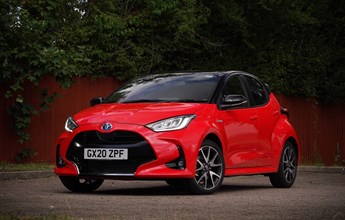We use cookies to ensure that we give you the best experience on our website. If you continue without changing your settings, we will assume that you are happy to receive all cookies on the Business Car website. However, if you would like to, you can change your cookies at any time

The start point for the best source of fleet information |
Model update: Toyota Yaris Hybrid Dynamic
Date: 07 June 2021 | Author: Sean Keywood

|
|
||||||||
When the new, fourth-generation Yaris supermini launched last year, Toyota put a lot of emphasis on its environmental and safety credentials, with its standard hybrid powertrain and comprehensive package of driver assistance systems. This message was then soundly drowned out by the launch of the GR Yaris, a rally-inspired, all-wheel drive, 261hp hot hatch that won rave reviews from enthusiast magazines and scooped a hatful of performance car awards, which Toyota was no doubt thrilled with. However, in Business Car's view, it would seem a shame if the noise around the GR meant the regular range was overlooked, since the original point about efficiency and safety should be right up our readers' street. So, having tested a non-UK spec car at launch, we took the chance to drive a right-hooker to see if the regular range can live up to its maker's initial claims and still deserves to be noticed amid the fuss over the GR.
There's only one powertrain option with the regular Yaris, and as mentioned already it's a hybrid, pairing a 91hp petrol engine with an electric motor for a combined 116hp. With PHEV superminis non-existent, this is enough to deliver class-leading official CO2 emissions, EVs aside, of 98g/km, alongside the Renault Clio E-Tech - and the Yaris can drop to 92g/km if specced differently.
On the road, the hybrid system can be left to its own devices to switch between petrol and electric modes as appropriate, but this can be overridden with a specific EV mode button, though in this mode we found it tough to get up to 30mph without the engine cutting back in. The engine can sound a bit gruff when called upon but isn't too noisy, while the CVT gearbox is a lot more proficient than they used to be around town, although droning revs do appear when accelerating at A-road speeds or joining motorways.
Performance from the Yaris is certainly adequate - Toyota says its engineers worked on improving in-gear acceleration compared with its previous hybrid system, and this is borne out as the engine feels nicely responsive in such situations, improving driveability. The powertrain will cruise on the electric motor for brief periods at motorway speeds, though mainly when going downhill, but it does this far more readily in town or B-road situations.
The suspension does a decent job of smoothing out bumps around town, where the Yaris also feels highly manoeuvrable, though the steering is overly light and doesn't breed confidence. It weights up a bit at higher speeds but remains numb and contributes to an uninvolving driving experience on B-roads, where the Yaris is functional rather than fun. Certainly, none of the GR Yaris's much-publicised sparkle is in evidence here.
The interior features large sections of scratchy plastics, which is disappointing with the Dynamic grade being just one rung down from the top of the regular range, while the overall aesthetic is very grey. On the plus side, the seats look good and are impressively comfortable. The 8in touchscreen is surrounded by shortcut buttons that don't feel very high quality, in fact they are reminiscent of those on an original Game Boy, and the graphics on the screen itself look a bit outdated. There's also no satnav but, with Apple CarPlay and Android Auto integration, a suitable smartphone system can easily be substituted. In front of the driver there's no full digital instrument display as seen now with some rivals, though the functionality of such a feature is arguably split between two 'dials' that are actually screens and a central TFT display.
Space in the back is reasonably good and, while a 286-litre boot is a touch on the small side for the segment, it doesn't suffer from the shallow profile sometimes caused by hybrid batteries, with these instead packaged beneath the rear seat.
As for the safety systems, Toyota's Safety Sense package is indeed comprehensive, with new features to the Yaris including night and day pedestrian and daytime cyclist detection for the pre-collision system and intersection turn assist to recognise collision risks at junctions. However, we found the collision warning system to be overly sensitive, as it kept being triggered by cars parked on the side of residential roads that we were never going to hit.
Toyota Yaris Hybrid Dynamic
P11D: £21,740
Residual value: 41.4%
Depreciation: £12,748
Fuel: £5,044
Service, maintenance and repair: £2,185
Cost per mile: 33.29p
Fuel consumption: 65.7mpg
CO2 (BIK %): 98g/km (23%)
BIK 20/40% a month: £83/£167
Luggage capacity: 286 litres
Engine size/power: 1490cc/91hp plus 80hp electric motor
Verdict |
8/10 |
|||
 |
|
 |
|
|











